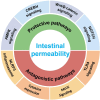Deciphering internal and external factors influencing intestinal junctional complexes
- PMID: 39150987
- PMCID: PMC11332634
- DOI: 10.1080/19490976.2024.2389320
Deciphering internal and external factors influencing intestinal junctional complexes
Abstract
The intestinal barrier, an indispensable guardian of gastrointestinal health, mediates the intricate exchange between internal and external environments. Anchored by evolutionarily conserved junctional complexes, this barrier meticulously regulates paracellular permeability in essentially all living organisms. Disruptions in intestinal junctional complexes, prevalent in inflammatory bowel diseases and irritable bowel syndrome, compromise barrier integrity and often lead to the notorious "leaky gut" syndrome. Critical to the maintenance of the intestinal barrier is a finely orchestrated network of intrinsic and extrinsic factors that modulate the expression, composition, and functionality of junctional complexes. This review navigates through the composition of key junctional complex components and the common methods used to assess intestinal permeability. It also explores the critical intracellular signaling pathways that modulate these junctional components. Lastly, we delve into the complex dynamics between the junctional complexes, microbial communities, and environmental chemicals in shaping the intestinal barrier function. Comprehending this intricate interplay holds paramount importance in unraveling the pathophysiology of gastrointestinal disorders. Furthermore, it lays the foundation for the development of precise therapeutic interventions targeting barrier dysfunction.
Keywords: C. elegans; Drosophila; Gastrointestinal diseases; Gut barrier; extrinsic modulators; intrinsic modulators; junctional complex; microbes; mouse model.
Conflict of interest statement
No potential conflict of interest was reported by the author(s).
Figures




References
Publication types
MeSH terms
Grants and funding
LinkOut - more resources
Full Text Sources
Molecular Biology Databases
